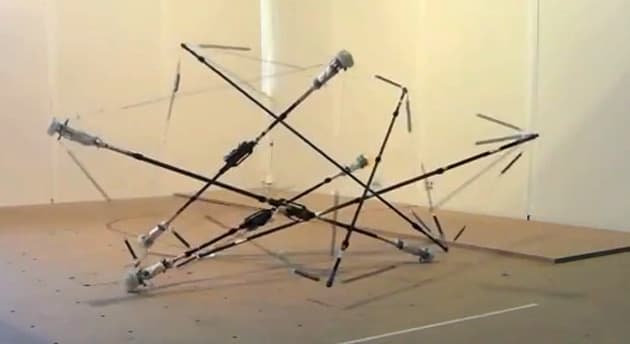NASA's Super Ball Bot may land on Titan - Saturn's largest moon
Engineers at NASA have designed a new kind of a robot, called Super Ball Bot, capable of exploring challenging terrains our solar system may offer. The bot does not look like your conventional bot at all! It's got a totally non-conventional structure which may allow for complete elimination of landing parachutes, airbags and even the retro-rockets. The Super Ball Bot is a creation of Vytas SunSpiral and Adrian Agogino at NASA's Ames Research Center in California. The duo have been on a mission of making the space exploration bots simpler in design and easier to transport to distant planets.

The bot has been built on the concept of tensegrity (tensional + integrity) - a new approach that first emerged in the art-world. The overall structure of the bot comprises of rigid structures - hollow cylindrical rods connected with each other through elastic cables. The structure is quite interesting itself - that it can take up heavy impacts by distributing the stress throughout the structure. It can move in any desired direction by contracting and releasing the elastic cables. Of course, the designers didn't target Mars as the ideal place for this bot to land; instead, they're aiming at the Titan - Saturn's largest moon which has a thicker atmosphere and can slow down the bot enough if dropped 100 km from above the surface.
The video below shows how the bot can be collapsed to a very compact configuration for transportation and popped open once it's ready for deployment. The researchers are currently busy solving the problem of precise movement of the bot; because even the small change in the connection length between the rods may change the direction of the bot significantly.
The hollow, rigid rods may carry all the sensors and communication equipment the robot may need to send all its findings back to the control stations on the Earth. What could be a big challenge is the power source of the bot. Traditionally, all the explorer bots have relied on Solar Power for charging their batteries.
We'd like to ask our CEans their opinion on this bot and probable fixes to power this bot once on the surface of Titan. Looking forward to all your interesting ideas & inputs.

The bot has been built on the concept of tensegrity (tensional + integrity) - a new approach that first emerged in the art-world. The overall structure of the bot comprises of rigid structures - hollow cylindrical rods connected with each other through elastic cables. The structure is quite interesting itself - that it can take up heavy impacts by distributing the stress throughout the structure. It can move in any desired direction by contracting and releasing the elastic cables. Of course, the designers didn't target Mars as the ideal place for this bot to land; instead, they're aiming at the Titan - Saturn's largest moon which has a thicker atmosphere and can slow down the bot enough if dropped 100 km from above the surface.
The video below shows how the bot can be collapsed to a very compact configuration for transportation and popped open once it's ready for deployment. The researchers are currently busy solving the problem of precise movement of the bot; because even the small change in the connection length between the rods may change the direction of the bot significantly.
We'd like to ask our CEans their opinion on this bot and probable fixes to power this bot once on the surface of Titan. Looking forward to all your interesting ideas & inputs.
0
